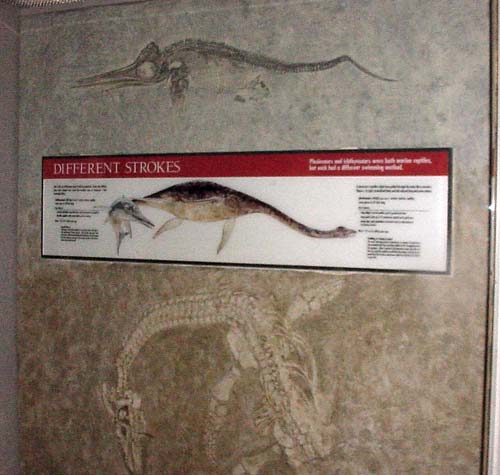Stroking Dinosaurs
The image below is a photo of this exhibit's fossils and pannel.

Approximate dimensions: H:5 ft W:5 ft D:3 in; The one piece is approximately 75 lbs.
These dinosaurs are on long-term loan from the California Academy of Sciences to be displayed here at CCSF. They were originally installed in the Life Through Time exhibit of The California Academy of Sciences . The fossils are casts made from originals held elsewhere. The bones are embedded in fiberglass, which simulates a rock.
PANEL TEXT
DIFFERENT STROKES
Plesiosaurs and Ichthyosaurs were both marine reptiles, but each had a different swimming method.
Like a fish, an ichthyosaur used its tail for propulsion. Some later ichthyosaurs were shaped very much like modern tuna or mackerel -- fast-swimming fishes.
Icthyosaurs (IK-thee-a-sorz): extinct marine reptiles; some grew to 50 feet long
New features:
- Vertical tail fluke used (with side-to-side movement) for propulsion
- Flexible paddles with extra digits used for steering
When? 235 to 85 million years ago to present
Smooth Moves
Ichthyosaurs looked like dolphins but swam like sharks, with side-to-side undulations of body and tail. Fully aquatic, they gave birth underwater. Well-preserved ichthyosaur fossils show traces of original skin color patterns; some were dark on top and pale on bottom, others were mottled overall.
A plesiosaur's paddles might have pulled through the water like a sea lion's flippers. Its rigid, streamlined body and tail reduced drag and extra motion.
Plesiosaurs (PLEEZ-ee-a-sorz): extinct marine reptiles; some grew to 45 feet long
New features:
- Long digits formed paddles use to propel and steer
- Long neck (with up to 70 vertebrae) snaked out to grab prey
- Large hips and shoulders increased area for attachment of swimming muscles
When? 215 to 65 million years ago to present
Paddling (or Flying) Around
The exact swimming mode of plesiosaurs is a matter of controversy. Some scientists think they used their paddles to fly through the water like penguins. Others maintain that plesiosaurs swam more like sea lions do, using their paddles to pull themselves along. It has been suggested that, like sea lions, plesiosaurs might have hauled out onto land to give birth.
PICTURE CAPTIONS:
- Ichthyosaur
- Plesiosaur